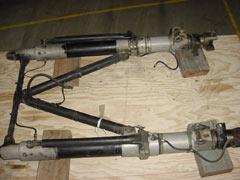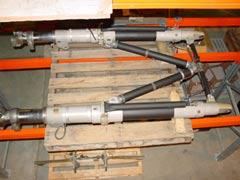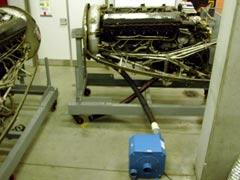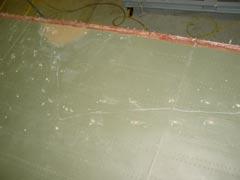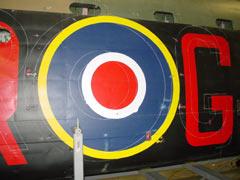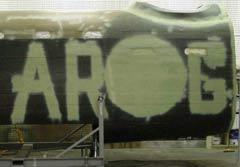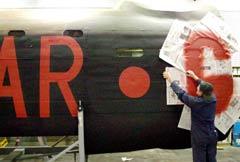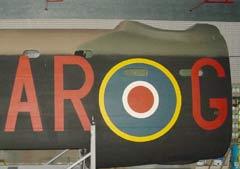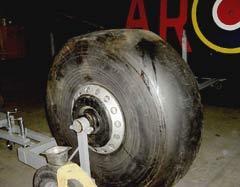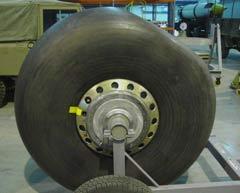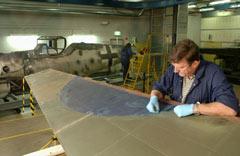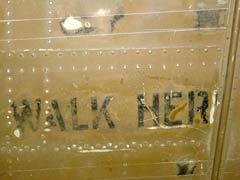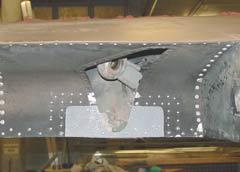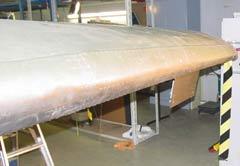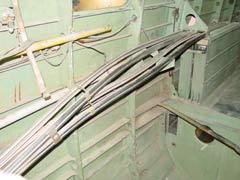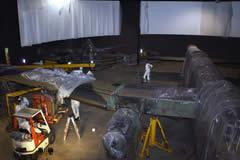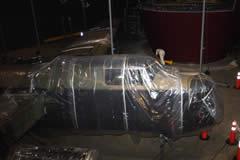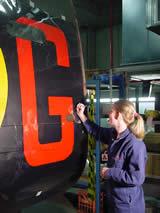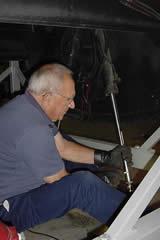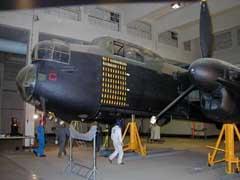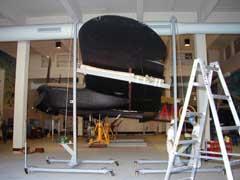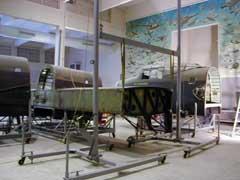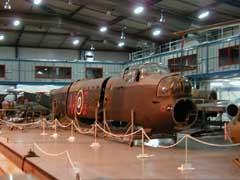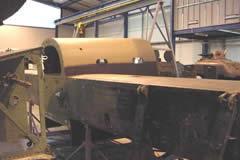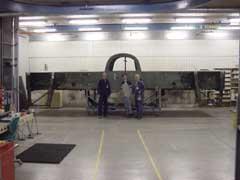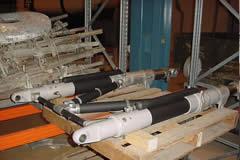Conservation project Lancaster G for George
"G for George" - Avro Lancaster Mk 1, serial W4783 [AR-G]
The Avro Lancaster was one of the most effective bombers of the Second World War. It possessed excellent range and speed and could carry a massive bomb load, twice that of its American counterpart, the B-17 Flying Fortress.
"G for George", the Australian War Memorial's famous Lancaster, was constructed in mid-1942 by Metropolitan-Vickers Ltd in Manchester, England. Upon completion, "George" was delivered for operations to 460 Squadron, RAAF, based at Breighton in Yorkshire. Its first mission took place on 6 December 1942 against the Germany city of Mannheim.
During the next sixteen months, "G for George" carried out some 90 bombing operations against Germany, Italy and occupied Europe. These included the famous raid of 17 August 1943 against the secret German Vergeltungswaffe (vengeance weapons - V-1 and V-2) facilities at Peenemünde on the Baltic coast, as well as 15 raids against Berlin. "G for George" was an incredible survivor of the worst part of the bomber offensive and no crew members were lost in the aircraft (although 40% of them were later killed in action). The bomber's last mission was flown against Cologne on 20 April 1944; it was withdrawn from service the following day.
"G for George" was flown to Australia during October-November 1944. In 1945 it toured eastern Australia as the flagship of the Third Victory Loan tour, where it helped raise funds for the war effort. At the end of this tour the Lancaster was delivered to the RAAF base at Canberra, where it rested, exposed to the elements, for ten years.
Installation of the Lancaster into the Australian War Memorial took place in 1955. "George" was dismantled and reassembled in Aeroplane Hall, where all work was completed in full view of the public. Since that time "George" has undergone some internal restoration work, including a new coat of paint in 1978. In 1999, "G for George" was dismantled and taken to the Memorial's Treloar Technology Centre at Mitchell, ACT, for major preservation treatment. The work planned includes complete disassembly, washing, chemical treatment, repainting, and the fitting of many missing parts. "George" has corrosion damage to the wings and fuselage and some original signatures (dating from 1945) in the interior are being lost as paintwork lifts and crumbles.
"G for George" is now on display in Anzac Hall.
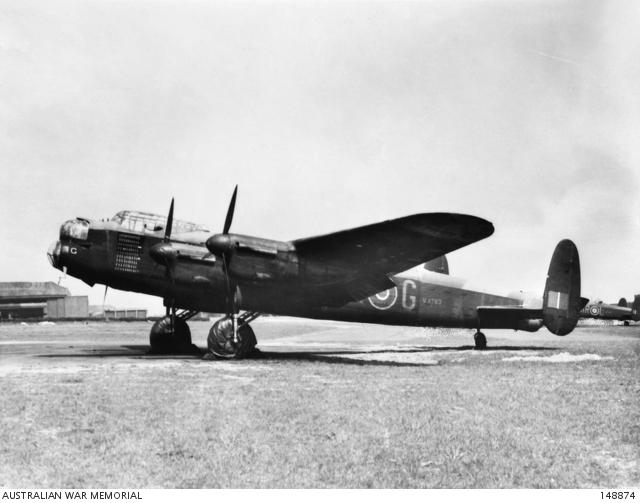
Lancaster Aircraft G for George of No. 460 Squadron RAAF 148874
Conservation Progress Reports
Read about the conservation of "G for George".
Conservation Progress Report - 2 April 2002
The nose section of the Lancaster fuselage has been cleaned, treated and repainted as closely as possible to its original appearance, using original photographs as references.
Further conservation work on the aircraft is progressing sequentially along the fuselage with the wing centre section now basically complete. Work on this section included cleaning, repair of past handling damage and replication of missing components. Spot rubbing through past external recoats was undertaken to establish original camouflage layouts. This enabled the repainting of the outside to the original outlines and colours. Care has been taken to accurately replicate the very low sheen "Night Black" paint used on the undersurface of the aircraft.
Internally the aircraft is not to be generally repainted, as much original paint still remains along with many historically significant signatures. Some previously repainted areas, however, have been recoated in a more accurate colour. Where internal paint is flaking attempts will be made to readhere this to retain the signatures, with inpainting as necessary on other areas. While the internal surfaces are being cleaned of dust buildups and potentially corrosive deposits of dirt and grease, significant operational staining has been left in place, for example exhaust stains from the engines along the front of the main spar. Some paint losses on the undercarriage have been inpainted.
Work is also progressing on the undercarriage components, and the corrosion inhibition of the four Merlin engines.
The treatment approach is to retain as much original surface as is possible, and repaint previously repainted surfaces to more accurately present the 1943-44 appearance of the aircraft in service.
John Kemister, Large Technology Conservator.
Conservation Progress Report - March, April & May 2002
A diverse range of conservation work has been done on the Lancaster during the last 2 months.
The structural elements of the undercarriage have been dismantled, cleaned and repainted.
Work is presently continuing on the wheels. The surface of the tyres is being treated to repair handling damage, and incorrectly applied paint is being removed from the brake hubs and wheels. These will soon be repainted in the correct colours.
All four of the Rolls-Royce Merlins have had their internal coolant passages flushed. Two of the Merlins have now been chemically treated, rinsed and dehumidified1. Soon, a vapourising corrosion inhibitor2 will be added to the water tanks and the radiator/water system will be sealed. Although the engines are largely complete, the work of locating small missing items like sparkplugs and wiring fittings continues.
The port wing and centre-rear fuselage are currently undergoing treatment. The inboard wing roots4, taboo ring5 and tail-gunner's ammunition tracks, which were damaged in the 50's, have been repaired.
Historical photographs and manufacturers documentation are being used in conjunction with spot rubbing3 to locate the original camouflage and aircraft identification markings. This means that for the first time in 60 years, George can be accurately returned to the paint scheme and markings it had while in active military service.
Andrew Pearce
Large Technology Objects Conservator,
Australian War Memorial
Glossary
Dehumidification means to remove all the moisture from a sealed airspace. In order for corrosion reactions to take place, water is needed. Dehumidifying stops this being able to happen.
An inhibitor is a chemical compound that prevents corrosion from occurring. A vapourising inhibitor can be enclosed in a sealed space and will flow through the system as a gas and coat the exposed surfaces of the metallic parts.
This is an investigative technique used to locate original markings which have been subsequently covered with newer layers of paint. Fine-grained abrasive paper is used to rub a small hole in the paintwork down to the original metal surface. Every layer of paint appears as a concentric ring of colour on the edge of the spot, with the oldest colours being nearest to the metal.
This is the most inboard section of a wing where it touches the aircraft fuselage. The joint between wing and fuselage is commonly covered with a cloth sealing strip or a metal fairing to smooth the airflow.
In the First World War, the guns mounted on aircraft were moved manually. With the advent of hydraulically and electrically powered turrets in the Second World War, it was discovered that a gunner could drive the gun barrels into the side of the fuselage damaging either the aircraft or the guns. The taboo ring fitted to the upper turret of the Lancaster prevents this. As the guns are moved, the small wheels protruding from the turret just below the guns operate a switch when they hit the curved track on the taboo ring. This switch operates the hydraulic system and elevates the guns, thereby ensuring a collision cannot occur.
Conservation Progress Report – June and July 2002
Much work has been done on the Lancaster project during June and July.
Fuselage
The centre rear fuselage has now been repainted. An undercoat was sprayed over the 1977 paintwork and new coats of "Night Black" and camouflage were applied. Finally, the squadron code and roundel were stenciled in using the tracings researched and prepared during May.
Undercarriage
The last two months has seen the completion of the undercarriage, with the treatment, cleaning and repainting of the main wheels. Careful inspection revealed the positions of creep markings* on both the hubs and tyres. Analysis of photographs within the Memorial's database also showed that the black and silver colours on the wheel hubs were not identical on each side of the aircraft.
Port wing
Although work has extended into some of June, the port wing of the Lancaster is now nearly complete. Again, careful spot rubbing has been used to confirm the position of all changes in camouflage.
Sheet metal work
Greg Brazel, the sheet metal worker employed full-time on the Lancaster project, has been very busy over the last few months. In the years before "G for George" arrived at the Memorial, the port wing was involved in a number of handling incidents resulting in damage that was never properly repaired. The trailing edge had quite bad tearing of the aluminium skin around the aileron control horn, while the leading edge had been involved in a significant collision resulting in extensive internal damage. Despite the internal damage in this section, the leading edge skin had simply been re-sheeted. Repairs that are both structurally sound and aesthetically in keeping with the remainder of the airframe have now been completed in these areas.
What next?
August and September will see the Lancaster team completing the port wing and get well underway on the starboard wing. Our volunteer teams will be working on the Merlin engine support frames and completion of the propellers.
Andrew Pearce
Large Technology Objects Conservator
Conservation Progress Report - August 2003
G for George has now been moved to Anzac Hall where it is being reassembled in preparation for its official unveiling on 6 December 2003.
Volunteers
Volunteers have made a significant contribution to conservation of "G for George" and other objects in the national collection. These are men and women with particular skills, skills in the metal fabrication area, welding, spray painting and machinists. These skills are utilised together with a strong commitment to conservation and cultural sensitivity. Volunteers come from a diverse background and, "are here because they want to be here". It is an opportunity to work in a unique museum environment. We would like to hear from people who are patient enough to spend a few hours cleaning and preparing the numerous bits and pieces that go into making up an historic aircraft, vehicle or artillery piece.
Photographs
Photoraphs of "G for George" taken during conservation treatment.
